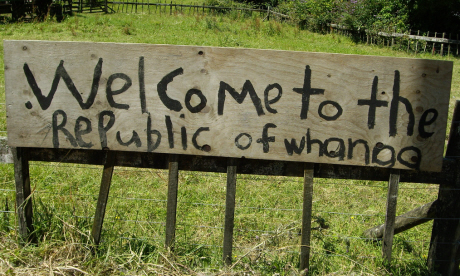
It's a small world
A glimpse into a republic where poodles have ruled and counting eels are a yearly event
Driving the curving roads of New Zealand’s Forgotten Highway (State Highway 43), you could blink and miss the sign welcoming you to the Republic of Whangamomona – a town-cum-nation with a population that barely makes up a football team and a main street with more chickens than people.
The corrugated-iron border checkpoint wasn’t manned as I drove into town. When there are no guards, most tourists pass by this bastion of security. I got out for a closer look.
Every traveller wants to find a nation that’s truly undiscovered – and maybe even get the nation’s ruler to pop the kettle on for them. Which is why I, like an increasing number of travellers, wanted to visit a micronation. Although unrecognised by the UN, these self-proclaimed countries are springing up in backyards or in unclaimed chunks of territory all over the world.
Micronationalists, as citizens of these homemade states call themselves, are a diverse breed. Some are secretive – isolationist, even – and don’t encourage outsiders. But others have extremely friendly heads-of-state, who’ll let international visitors into their own homes. While some travellers are content to collect stamps in their passports, by buying citizenship of a micronation you can collect entire passports.
But how can you know if you’re getting a passport to a genuine micronation? Many micronations use the 1933 Montevideo Convention on the Rights and Duties of States to define themselves. This UN document holds that a nation only needs four things to exist: a permanent population, defined territory, government and the capacity to enter into relations with other states. It’s those pesky other states that usually lead to secession.
Would-be micronationalists usually have a dispute with a state or national authority that makes them decide to live in a nation all of their own. Whether it’s protesting against a freeway in Florida or making a sanctuary for pot smokers in Denmark, there are plenty of reasons why micronationalists wouldn’t see eye to eye with their former governments. Whangamomona is no different.
My meeting with the president of Whangamamona, Mr Murt Kennard, wasn’t for another half an hour, so I decided to do some additional research in the Whangamomona Hotel, the local pub. The walls were papered with news stories about how this little town seceded from New Zealand when the local council threatened to re-zone the township from their much-beloved Taranaki into another district.
The locals met up in this very boozer and decided – mainly because they didn’t want to play rugby for a different district – that it was time to give the Kiwi motherland the shove. My half-finished pint was doubly significant: I was drinking the national beer in the very birthplace of government. I bought a passport, T-shirt and another pint to celebrate.
Across the road from the pub I found the town’s only other major business, M&M’s Café – home to Murt and his first lady, Margaret. The latter faced me as I entered. I explained that I was hoping to have a chat with the president if he was about. “He’s been fixing a table in the shed, but he might have time for a cuppa,” she said, and went off to find Whangamomona’s commander-in-chief.
When Murt walked into the room, with his long biker beard and huge stature, he seemed more of a bear than a man. “Gidday, I’m Murt.” He threw out a paw to commence diplomatic relations. Given that Murt’s predecessors were a poodle and a goat, I was lucky he could even talk. But out the back of the café over the promised cuppa, Murt had nothing but respect for his predecessors. He reckoned Tai the poodle had “a personality of his own; he was a very good president”. And when asked about the state funeral of Billy the goat, there was more than a gleam of sorrow in his eyes: “Well, it was a sad time for us. All his offspring wandered in off the hills for the funeral. And he had quite a family…”
Apparently, Billy had a reputation for being quite the playboy, so Murt – the first Whangamomonan head of state to be married – represents a return to family values in the republic. He divides his time between duties of state, working on the roads around town and “keeping young fellas’ cars going while they get a bit of money”. Margaret, meanwhile, is responsible for the café’s Whanga burgers, and plays netball for the Whanga Wasps.
On Republic Day (next celebrated in January 2007) special trains come down from Auckland to fill the main street with revellers. “We have things like ‘count the eels in the bath’, sheep races in the main street, possum skinning and sheep shearing,” Murt chuckled.
As he talked, Murt’s chain of office caught my eye. Clipped to the thick necklace were dented beer can tops, local boar tusks and some small unidentifiable orange nuggets. “Those are for boring meetings,” Murt explained – and then ate one. “Dried fruit,” he explained.
Maybe it was the two pints giving me delusions of grandeur, but I had a sudden urge to wear the chain myself. Ever the diplomat, Murt growled quietly: “You’ve got to be voted in to wear it. That was too cheeky.” With a near-international incident narrowly avoided, it was time to head for the border and the large sign that told me: You are now leaving the Republic. Welcome back to New Zealand.
